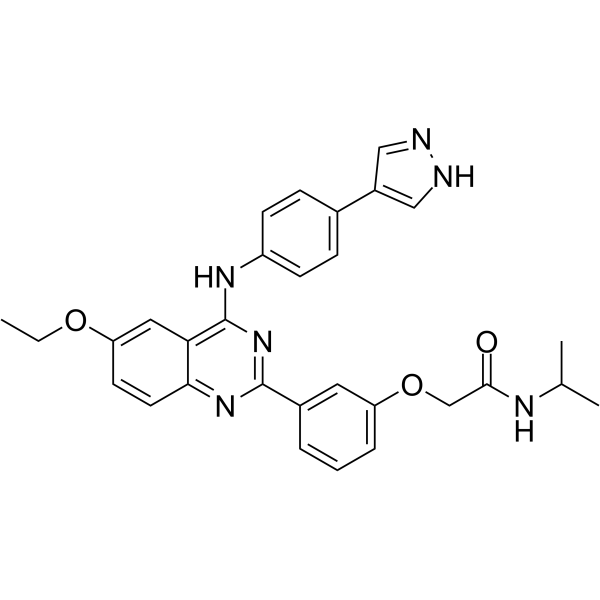KL-11743 |
| カタログ番号GC64014 |
KL-11743 は、クラス I グルコース輸送体の強力な経口活性型グルコース競合阻害剤であり、GLUT1、GLUT2、GLUT3、および GLUT4 の IC50 はそれぞれ 115、137、90、および 68 nM です。
Products are for research use only. Not for human use. We do not sell to patients.

Cas No.: 1369452-53-8
Sample solution is provided at 25 µL, 10mM.
KL-11743 is a potent, orally active, and glucose-competitive inhibitor of the class I glucose transporters, with IC50s of 115, 137, 90, and 68 nM for GLUT1, GLUT2, GLUT3, and GLUT4, respectively. KL-11743 specifically blocks glucose metabolism. KL-11743 can synergize with electron transport inhibitors to induce cell death[1][2][3].
KL-11743 (compound 8) competes with glucose for binding to GLUT1, with IC50s of 33 nM and 268 nM at 0.37 mM and 10 mM glucose, respectively[1].KL-11743 (39-10000 nM; 24-72 h) dose-dependently inhibits the growth of HT-1080 cells, with an IC50 of 677 nM[3].KL-11743 inhibits the growth of KEAP1-mutant lung cancer cells with more potency compared to KEAP1-WT lung cancer cells[4].KL-11743 (0.001-10 μM) induces a rapid increase in the phosphorylation of AMPK and acetyl-coenzyme A carboxylase in HT-1080 cells [3].KL-11743 (2 μM) inhibits glucose uptake in 786-O cells. KL-11743 increases NADP+/NADPH in NCl-H226 cells. KL-11743 induces cell death in SLC7A11-high cancer cell lines (NCl-H226 and UMRC6 cells)[2].KL-11743 (0.001-10 μM) inhibits both glucose consumption, lactate secretion, and 2DG transport in HT-1080 fibrosarcoma cells, with IC50s of 228, 234, and 87 nM, respectively, and fully inhibited glycolytic ATP production in oligomycin-treated cells with an IC50 of 127 nM[3].
KL-11743 (100 mg/kg; i.p. every two days for 5 weeks) decreases the growth of SLC7A11-high NCI-H226 xenograft tumors and was well-tolerated in vivo[2].KL-11743 (30-100 mg/kg; a single p.o.) significantly elevates blood glucose levels and delays glucose clearance in mice challenged with 5 g/kg glucose[3].KL-11743 significantly suppresses the growth of KEAP1 KO tumors[4].Plasma levels of KL-11743 (100 mg/kg; i.p.) are maintained at inhibitory levels for most of the 24-hour dosing period[2].KL-11743 (p.o) exhibits moderate oral between 30% and 15%, and favorable and dose-linear plasma exposure profile reaching concentrations of approximately 20 μM in mice (10-100 mg/kg) and rats (10-300 mg/kg)[3].KL-11743 exhibits comparable half-lives ranging between 2.04 and 5.38 h in rats (10 mg/kg for i.v.; 10-300 mg/kg for p.o.), and 1.45-4.75 h in mice (10 mg/kg for i.v. and i.p.; 10-100 mg/kg for p.o.)[3].
[1]. Liu KG, et, al. Discovery and Optimization of Glucose Uptake Inhibitors. J Med Chem. 2020 May 28;63(10):5201-5211. [2]. Liu X, et, al. Cystine transporter regulation of pentose phosphate pathway dependency and disulfide stress exposes a targetable metabolic vulnerability in cancer. Nat Cell Biol. 2020 Apr;22(4):476-486. [3]. Olszewski K, et, al. Inhibition of glucose transport synergizes with chemical or genetic disruption of mitochondrial metabolism and suppresses TCA cycle-deficient tumors. Cell Chem Biol. 2021 Oct 22;S2451-9456(21)00441-4. [4]. Koppula P, et, al. KEAP1 deficiency drives glucose dependency and sensitizes lung cancer cells and tumors to GLUT inhibition. iScience. 2021 May 25;24(6):102649.
Average Rating: 5 (Based on Reviews and 4 reference(s) in Google Scholar.)
GLPBIO products are for RESEARCH USE ONLY. Please make sure your review or question is research based.
Required fields are marked with *




















